Mauritius holidays offer complete relaxation, but for those who like to explore, keep reading. The island may be small, but there’s plenty of things to in Mauritius as you’ll discover in this guide.
Black River Gorges
Top of the Mauritius sightseeing list should be a trip to the Black River Gorge National park. Its the largest national park on the island and its where you’ll find some of the best natural Mauritius attractions.
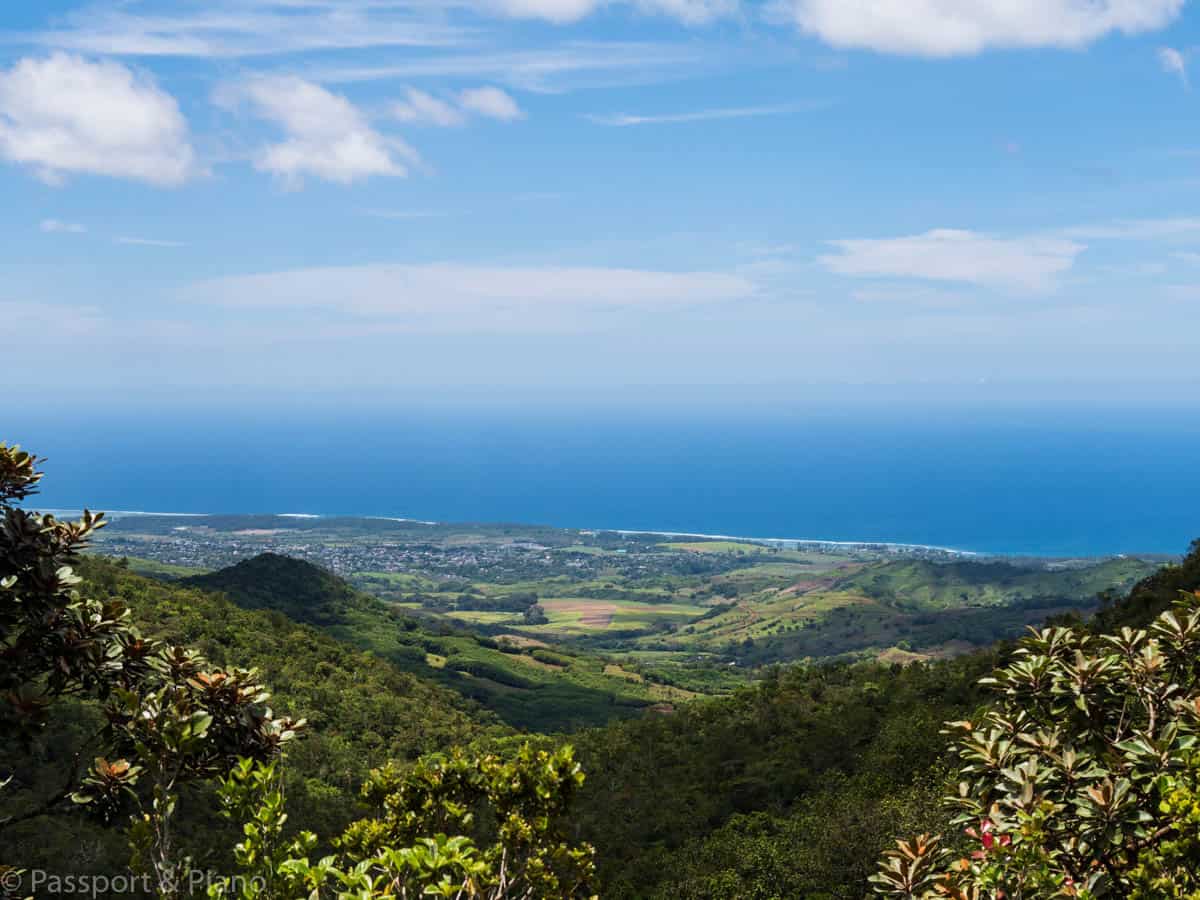
The parks conservation area covers 6,574 hectares, much of which is covered by hiking trails. However, if walking isn’t your thing you can take a scenic drive through the park.
Petrin Visitors Centre
Although the visitor’s centre is small and frankly it contains little information, there are toilet facilities here. You can also pick up a map of the area here for a small fee. There is also a map on the wall which you can take a picture of if you don’t wish to purchase one.
What is worth seeing here is the open aviary behind the centre. Here you can see the pink pigeon conservation project in action. They may not be one of the worlds most beautiful birds, but they are prettier than your average pigeon.
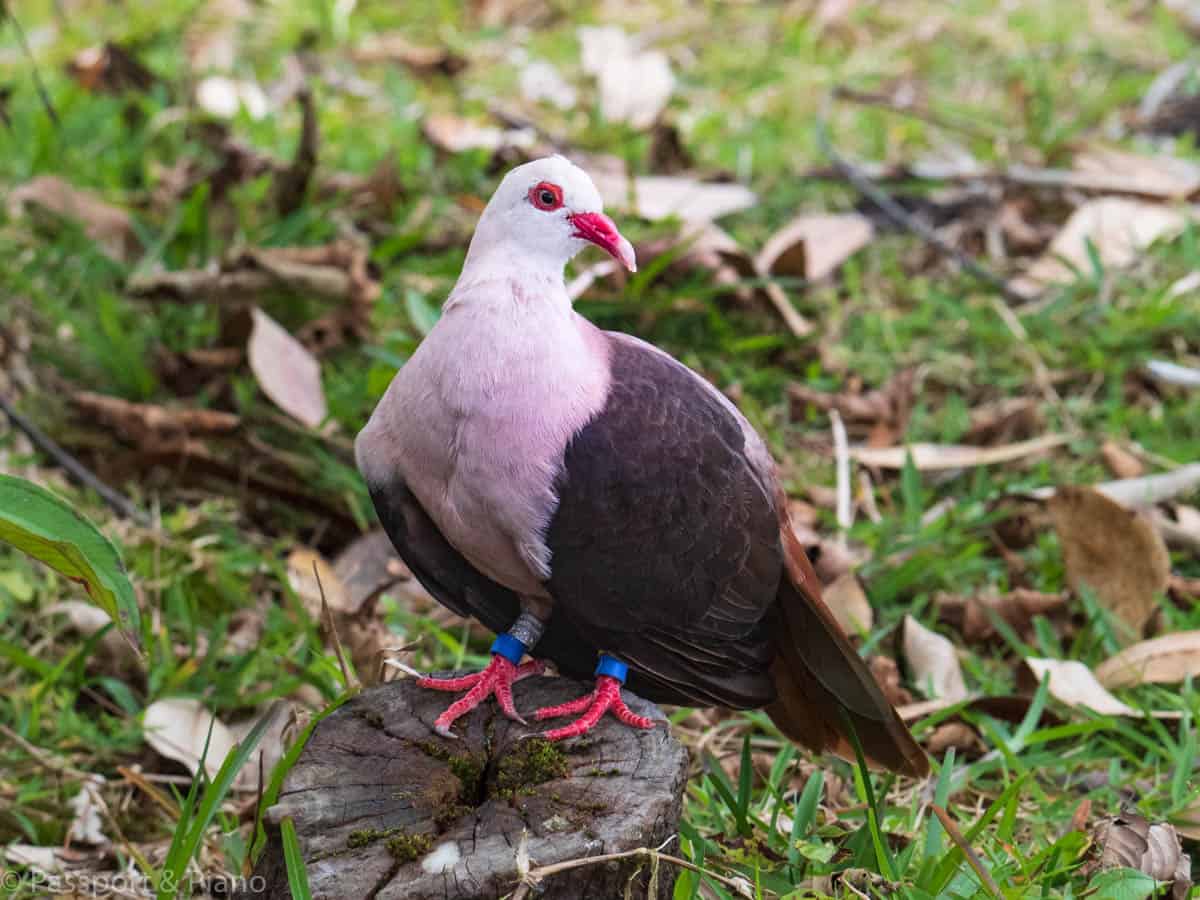
Pink Pigeons were until recently critically endangered birds. In 1990 there were only ten species left, but thanks to conservation efforts there’s now thought to be approximately 500.
The open aviary provides your best chance of seeing these rare birds. Due to loss of habitat, there are now feeding stations to supplement their diet, and the aviary here is one of them.
The birds are free to come and go, but when we visited, there were at least 15 of them to admire. We also spotted a Tang foraging around for food. Originally native to Madagascar these curious creatures across Mauritius, Réunion and Seychelles.

Keep your eyes peeled for other local wildlife while in the area. If you are lucky, you might see the Mauritian kestrel in the forests which are even more endangered than the pink pigeon.
Another rare species found in the woods is the echo parakeet, which is bright green and generally lives in the canopy of the forest.
Another favourite to look out for is the Mauritian flying fox. However, you can see these giant bats in various spots around the island. Flying Foxes can have a wingspan of up to 80 cm, and in the black of the night, they are both a haunting and magnificent sight.
Hiking in Black River Gorge
There are several walks that you can take from the visitor’s centre. However, you will need to allow at least half a day to incorporate one into your schedule.
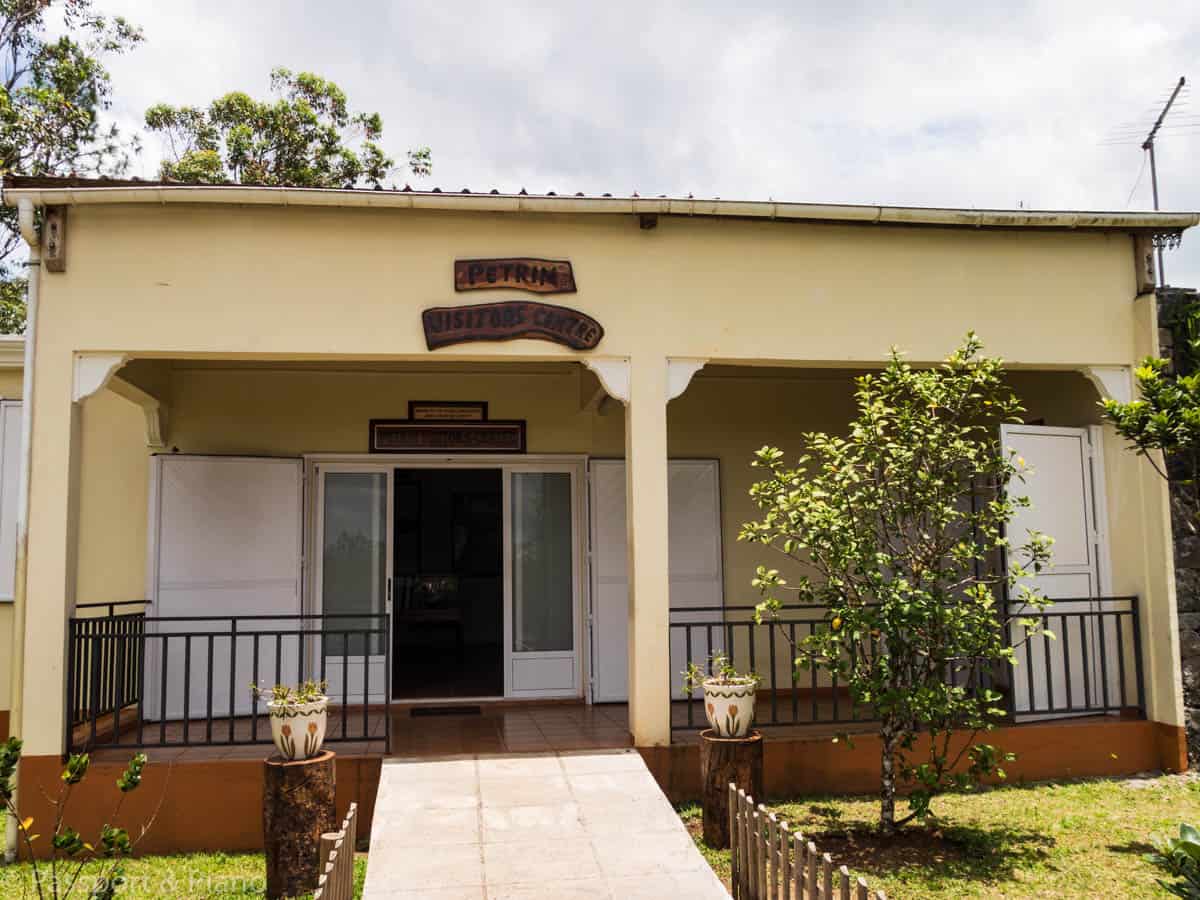
There is parking at the Petrin centre, and signposts guide you around the routes. Below is a list of the most common trails, but there are many others in the area.
Macchabée Trail – 10km
The Macchabée Trail takes around 4 hours one way, so you’ll need to organise a taxi to collect you from the Black River Gorges Visitors centre at the end of the route.
It’s a strenuous hike that takes you across the park, but if you are physically able the spectacular viewpoints are some of the best Mauritius sights.
Along the way keep your eyes peeled for the Mauritius Kestra, Echo Parakeet and the soaring Tropic birds with their magnificent long tails.
Mare Longue Reservoir trail
If you are looking for a long walk that will return you to the visitor’s centre at Petrin the Mare Longue trail is a good option.
It’s a 12km walk of moderate difficulty which you should allow four hours to complete. It begins and ends at the Pétrin visitors centre and takes you through a native dwarf forest to the northern tip of the park.
Here you’ll find a large reservoir which is rarely visited and sightings of the rare pink pigeon and endangered echo parakeet are possible.
Macchabée Forest Trail
If you are after a reasonably accessible walk, then this trail is for you. It’s a moderate 8km hike that takes you on a loop through the tropical forest and back to the Petrin visitor’s centre.
Make sure you spray yourself with bug spray before you set off and wear suitable footwear as the trail can be muddy in places.
Macchabée Loop
If you like the sound of the Macchabée trail but don’t fancy organising a taxi at the other end, then the Macchabée loop is a better option. It takes you to the spectacular viewpoint where you can turn back and trek along the same path back to the Petrin visitor’s centre.
It’s a moderate 8km hike that will take you approximately three hours to complete.
Driving through the Black river Mauritius National Park
Before setting off, it’s worth taking a short detour to see the Grand Bassin, which is one of the places of interest in Mauritius. Long before you reach the lake, you’ll see the magnificent and giant Shiva statue which guard this sacred Hindu site.
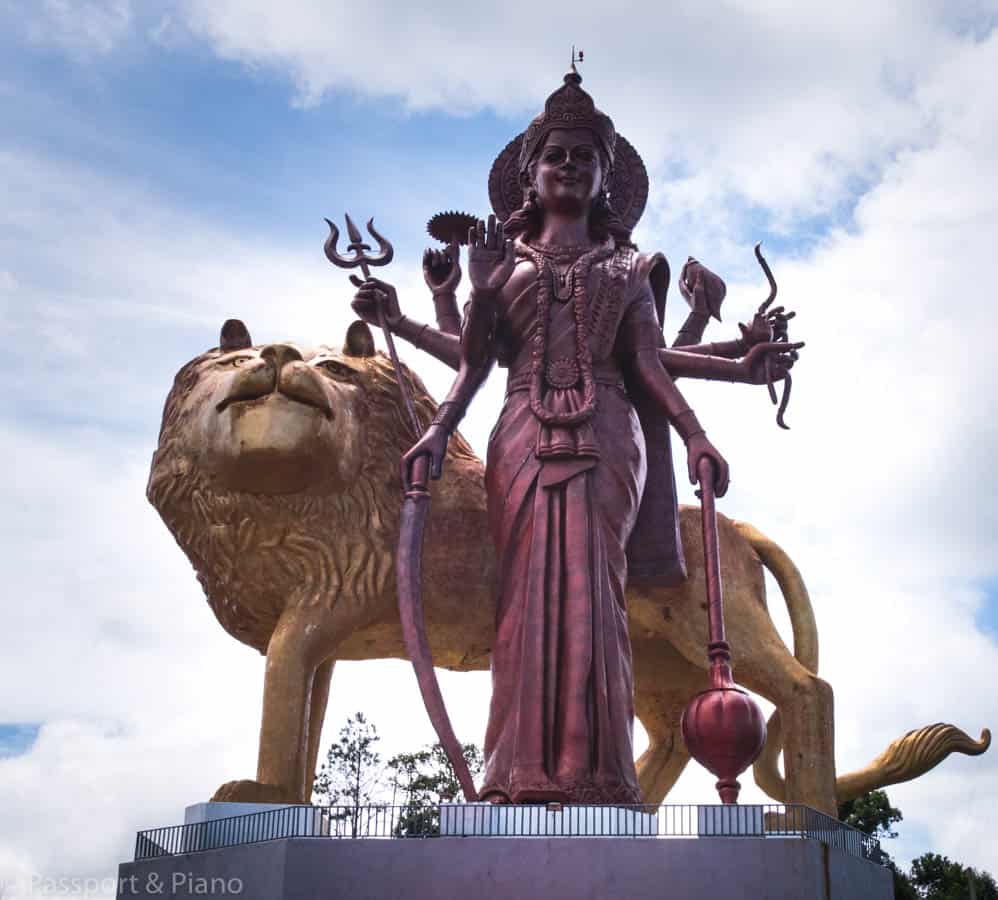
On the edge of the lake sits a temple which is the most sacred of Mauritius places to visit. Its an important pilgrimage site for Hindhu’s on the island, and many make the journey on foot during the festival of Maha Shivaratri.
You can visit the temple but remember to take your shoes off before entering and dress appropriately. Entrance is free, although donations towards the upkeep of the site are welcome. There’s ample parking and toilet facilities there.
Scenic Drive
From the Pétrin visitors centre car park turn left and head towards Alexandra falls, then follow the signpost at the junction. The falls is the first stopping point on this route.
Alexandra Falls
Follow the signs to the car park and take the short walk to the viewing point for the falls. Surrounded by the lush green landscape Alexandra Falls looks magnificent as it cascades over the rocky outcrop.
Located some 700 meters above the sea level, the electrifying green of the region, the diverse luxuriant flora and fauna and the magnificent landscapes altogether make it an excellent way to connect with nature.
The observation tower was closed when we visited as it was no longer safe. To see the falls clearly, you had to stand on the wall, which was somewhat precarious.
Hopefully, the park will build a new tower shortly so that everyone can enjoy the glorious view. Meanwhile, it’s still worth a visit as the scenery is beautiful.
Champagne Police Post
Continuing along the main road, you’ll pass the Plaine Champagne Police post, just after which is another well-known hiking trail.
The Parakeet trail is a strenuous 8km walk in one direction that takes you down into the gorge. Look out for the Echo Parakeets which you stand a good chance of seeing along this route. You then walk along the river until you reach the Black River Gorges visitors centre.
Gorges viewpoint
Approximately 8km past the police post is the Georges viewpoint, a Mauritius must-see viewing point.
You’ll easily spot it from the road as everybody stops here and there’s a small souvenir market on the path leading down to the observation deck.
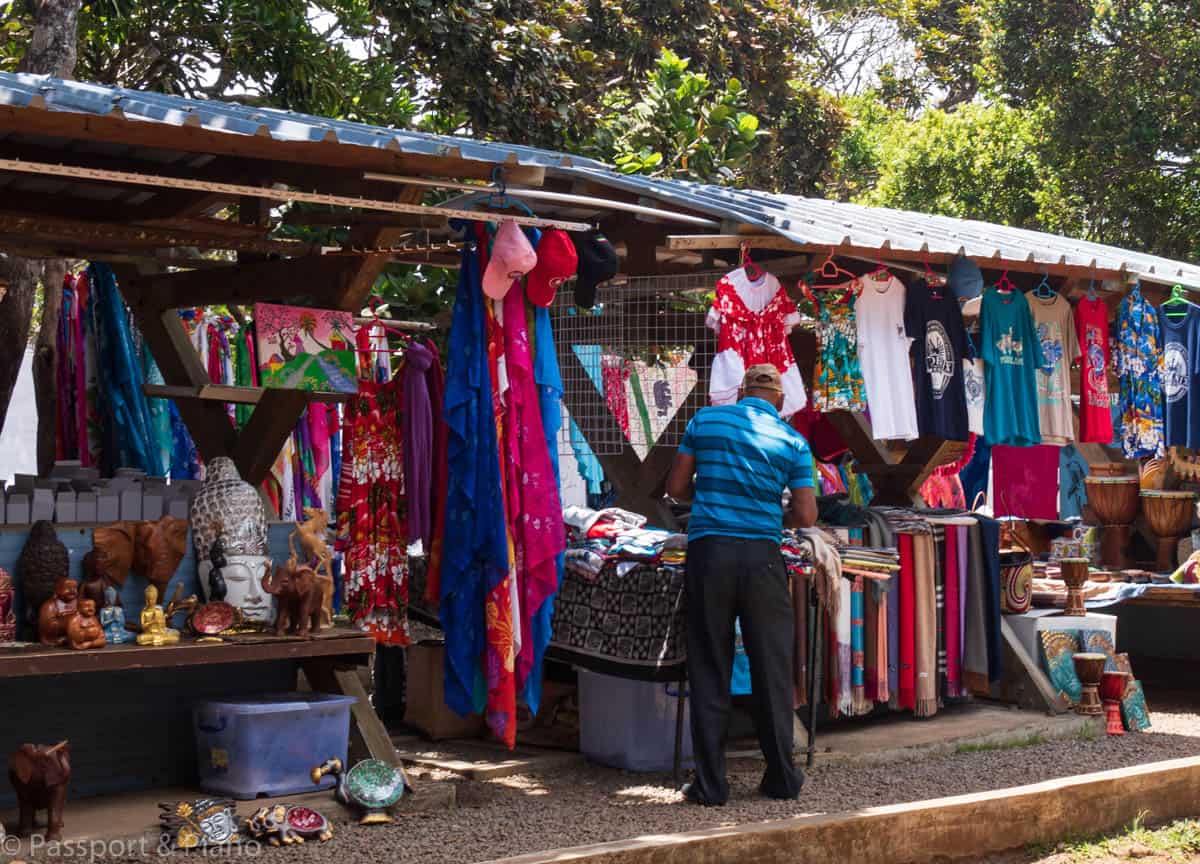
The panoramic view is stunning, and on a clear day, it’s easily the best view of any on the island. To the right across the lush green fauna, there’s a spectacular waterfall that cascades over rocky outcrops into the gorge beneath.
Make sure you keep your belongings safe, especially around the car park as the local monkeys are always on the scavenge.
Rhumerie de Chamarel
A further 6km up the road from the gorges viewpoint is one of the best-loved attractions in Mauritius and a great place to stop for lunch.
Rhumerie de Chamarel is a rum distillery that still cultivates its sugar cane. The harvest is done by hand and transferred within 4 hours to the distillery to ensure the aromas are still fresh.
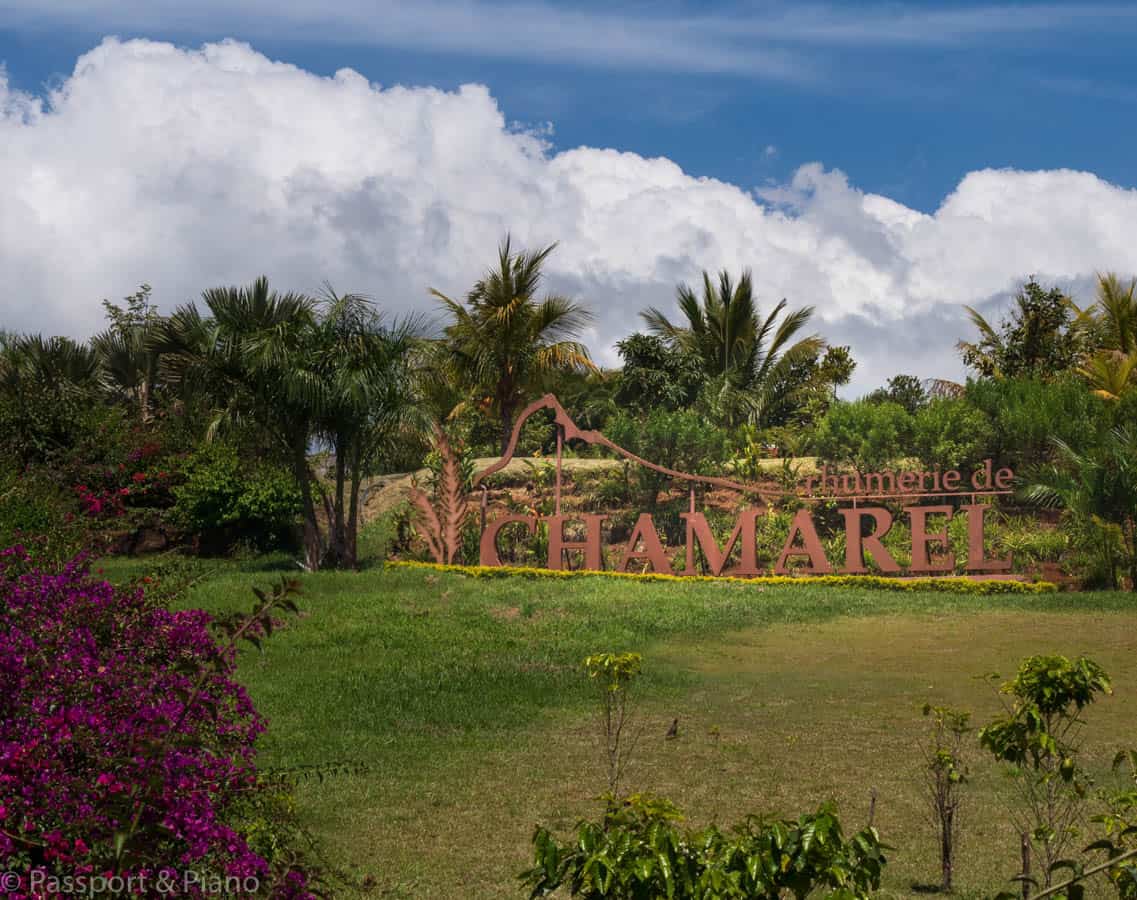
You can enjoy afternoon tea on the terrace or lunch in the restaurant with delicious local delicacies such as palm heart to devour. You can take a tour of the distillery, and there’s an onsite shop if you wish to purchase some of their premium rum or liqueur to take away.
Terres de 7 Couleurs
Continuing along the route, you’ll pass through the village of Chamarel which has some excellent restaurants, many of which sell local Mauritian food.
Follow the signs to Terres de 7 Couleurs, which is one of the more unusual places to see in Mauritius.
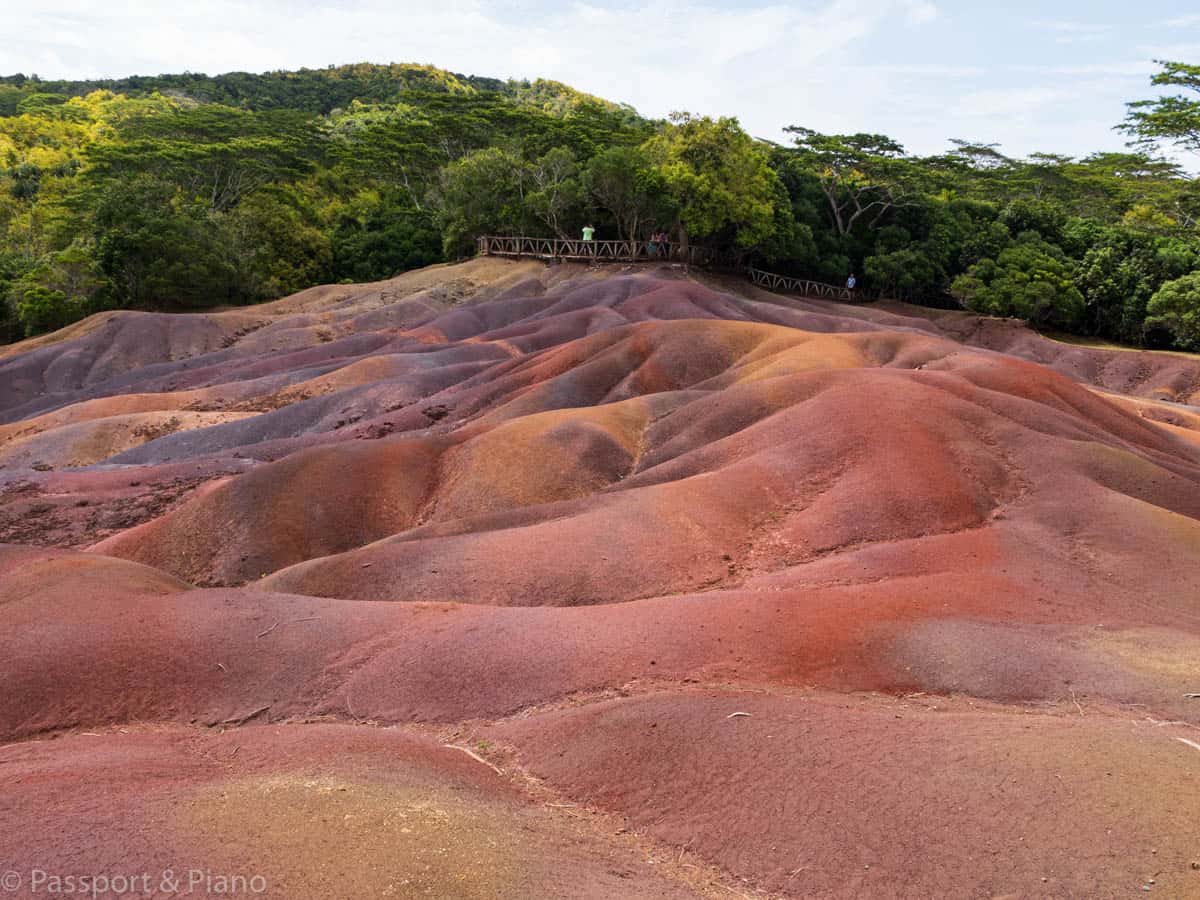
The famous coloured sand that is a result of uneven cooling in molten rock from past volcanic activity lies in an estate that Charles de Chazal de Chamarel once owned.
Visitors now flock here to see the seven distinct colours of sand which are unique and sit unusually amongst the well-manicured grounds. There’s a walkway around the colourful mounds and several viewing points where you can stand in awe at the magnificent colours.
The sand glows differently depending upon the angle of the sun, and the striking hues of reds are genuinely spectacular.
Giant Tortoise
To the right of the coloured earth is an enclosure that houses giant tortoise.
The tortoise is originally from Aldabra in Seychelles, but as the Mauritius one is now extinct, the wildlife foundation imported these to help with conservation efforts.
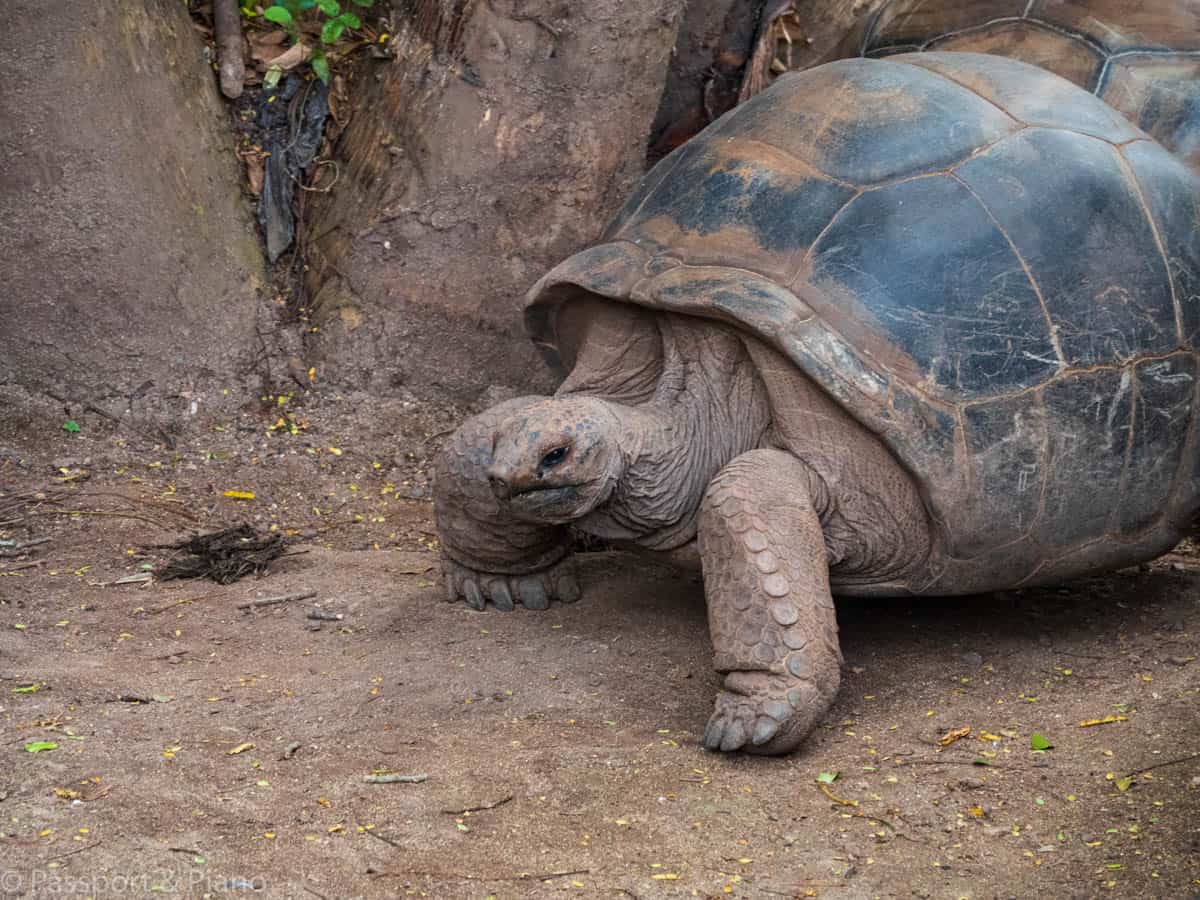
On the estate, the Chamarel waterfall is worth a quick stop. There’s a stunning viewpoint from the car park, or you can walk to it from the coloured sand.
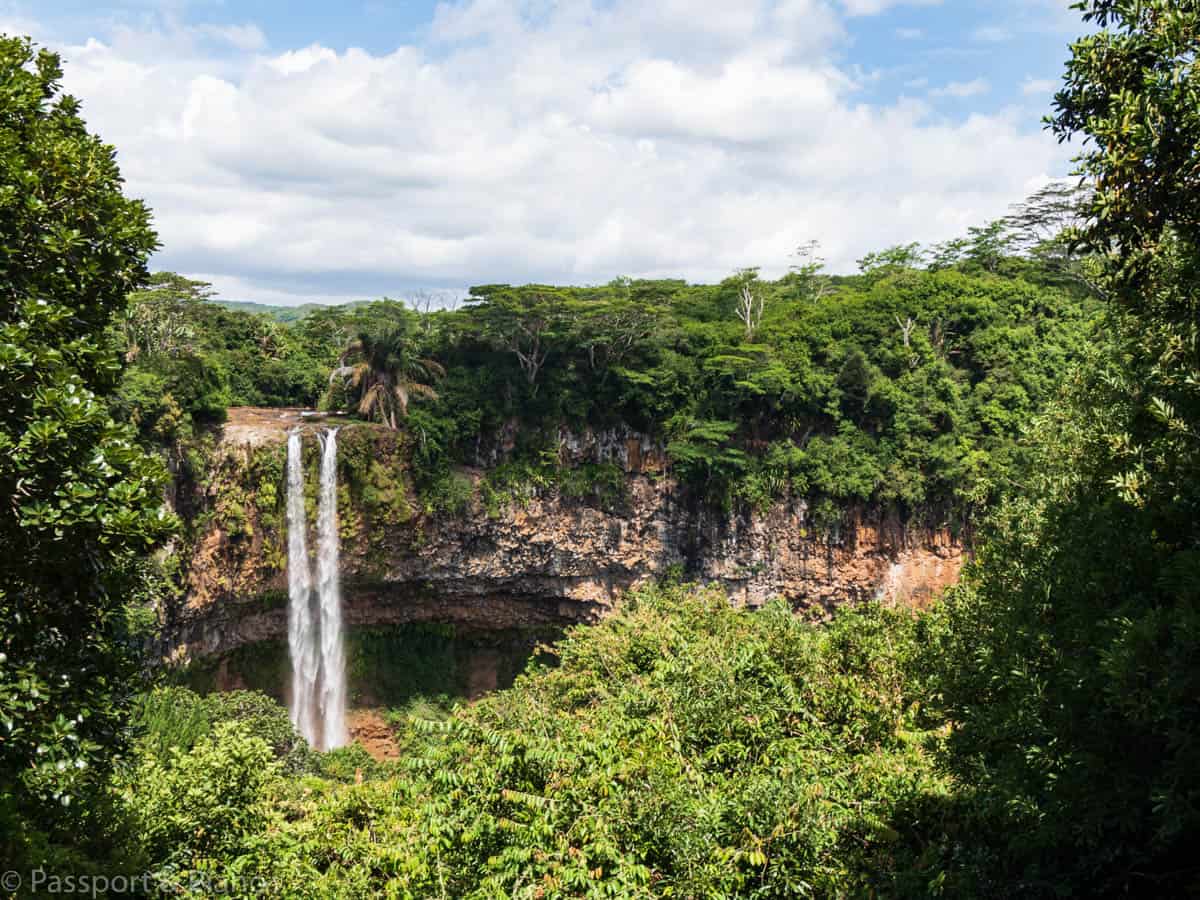
There’s also a cafe with a seating area that has fantastic views over the coloured earth from the terrace balcony.
Curious Corner of Chamarel
Opposite the entrance to the 7 coloured earth is one of the quirky Mauritius tourist attractions. The curious corner of Chamarel will stimulate and tease anyone mind, especially after enjoying the natural wonders of the Black Gorge National Park.
There are over 40 exhibits inside that are set to challenge your brain with puzzles, fun illusions and interesting optical reflections that will trick the mind.
You can have fun and fulfil your creative side in the laser music room, get lost in the mirror maze and baffle your brain in the upside-down room. To explore all the attractions set aside an hour and a half.
Eureka Historical Mansion
The19th century Creole mansion known as Eureka is the islands largest house. A British aristocrat built called Mr Carr built the house in 1830, and he chose Mokka as the location as it was close to Le Réduit, the former governor general’s home.
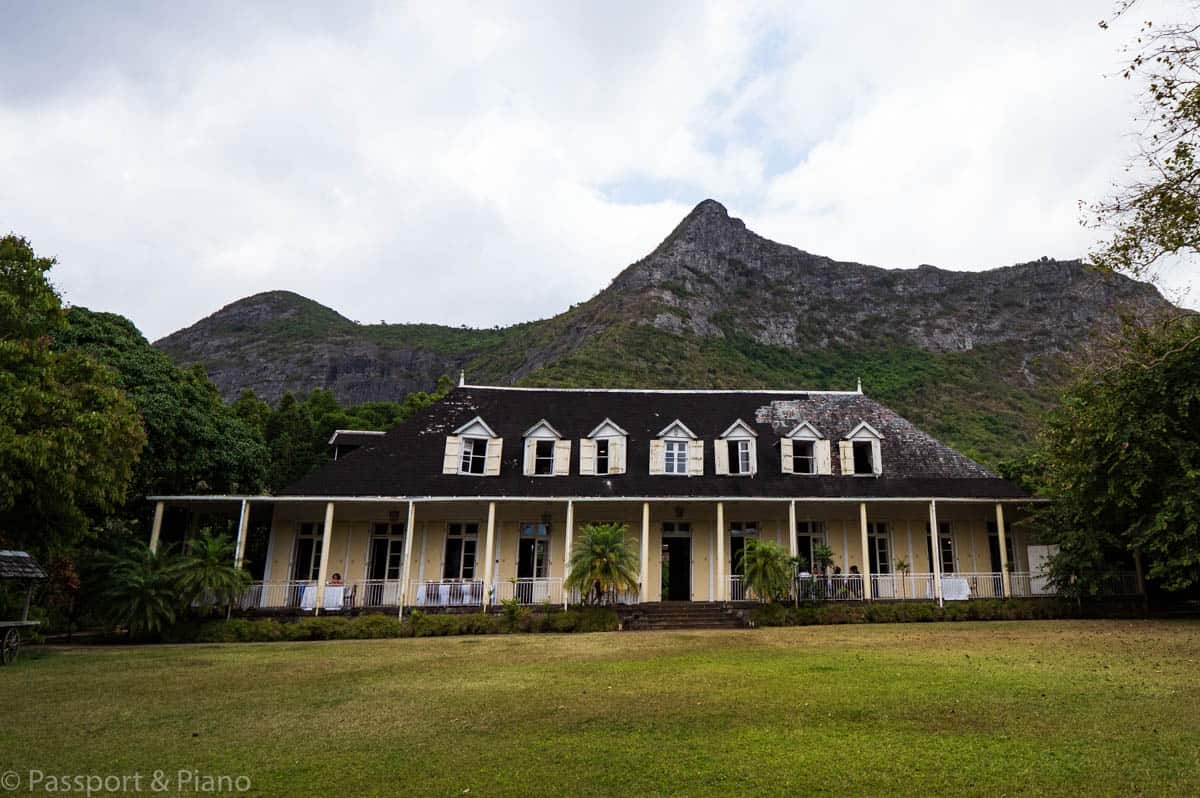
The house was an old sugar plantation and surrounding the property is 6 acres of lush green gardens including a couple of significant waterfalls. To make the most of the exquisite views the house as a delightful veranda that encircles the house.
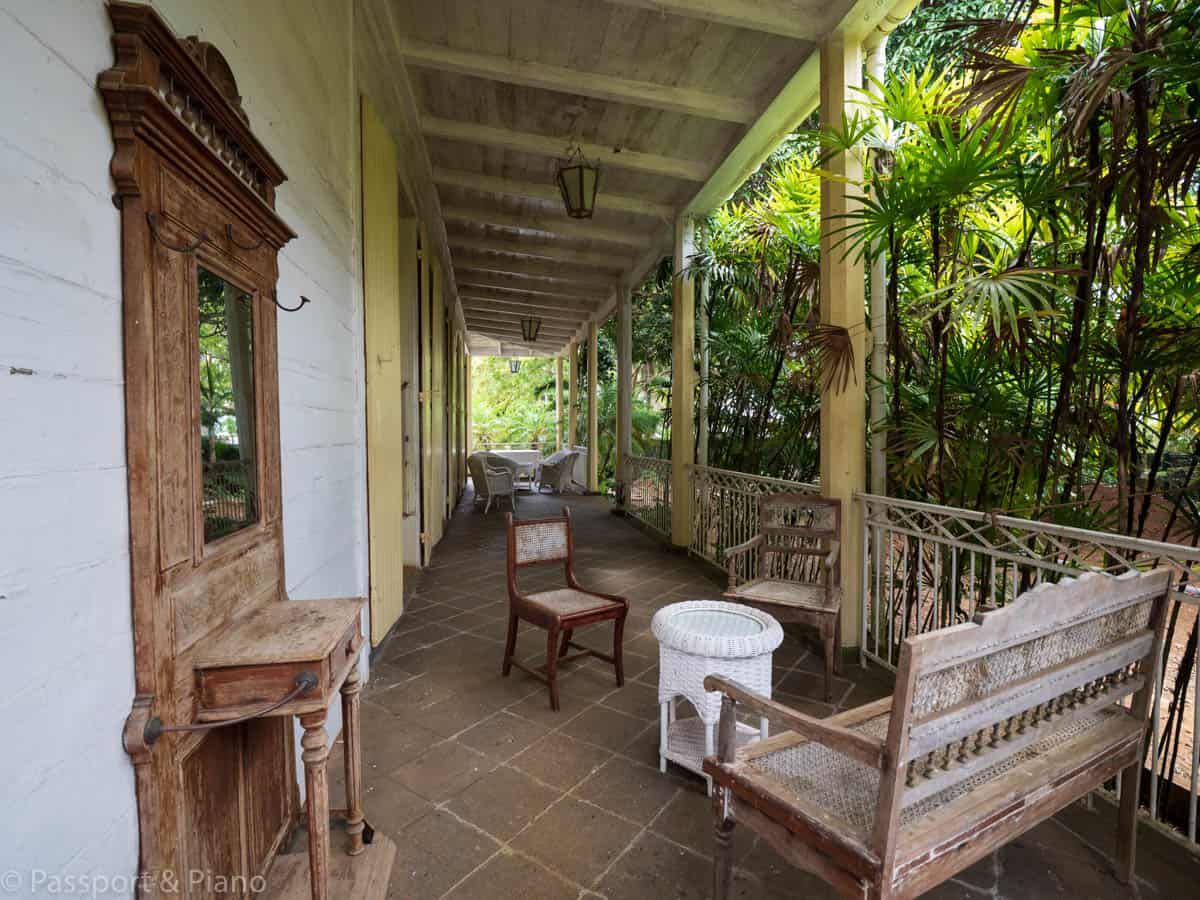
Mahogany and ebony wood was used in the construction of the house and with its 109 doors and windows, it was no mean feat for the carpenters. The home includes furnisher imported by the French East India Company, and there’s a good collection of antiques on display.
There are some unusual items, including a bath with a shower feature and a statue of a dodo decorated with peacock feathers. The old kitchen is in a separate outhouse. Although it now has modern appliances, it still serves the onsite restaurant.
You can see some of the original kitchen implements, including the stones used to grind sugar at the front of the building. There are also other household antiques such as an early sewing machine and iron on display.
Eureka Gardens
The gardens that surround the beautiful mansion are worth exploring as there’s some rare endemic plants as well as magnificent palm and mango trees. There’s a short albeit steep walk down to two waterfalls which are worth seeing.
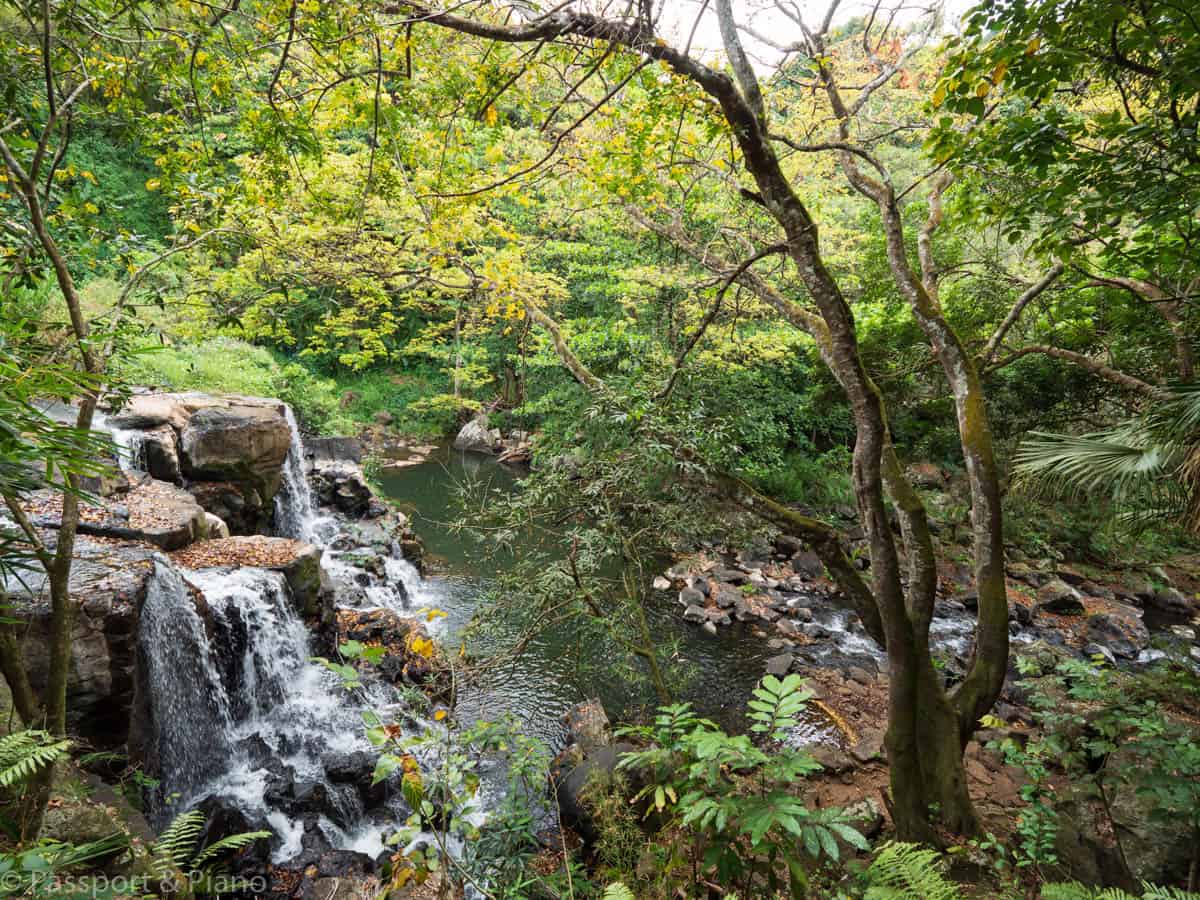
Both British and French aristocrats have lived in the house, and a tour around the property gives an exciting insight into the colonial life.
In 1856 Mr Eugène Le clézio bought the house and his reaction after his successful purchase was Eureka, hence the name of the property.
Many generations have lived there since, but when Simone Le clézio died in 1980, he left Eureka to Fernand Le clézio who sold the property to two estate agents in 1985.
Fortunately plans to develop on the land did not come to fruition and Jacques de Maroussem whose wife Monique d’Arifat was the great-grandchild of Sir Henry Le clézio was able to repurchase the property for the family.
The couple is now divorced, and in 1986 the house was restored and opened to the public as a museum.
Pamplemousse
The Sir Seewoosagur Botanic Garden is one of the most popular Mauritius tourism attractions and the oldest botanical garden in the southern hemisphere.
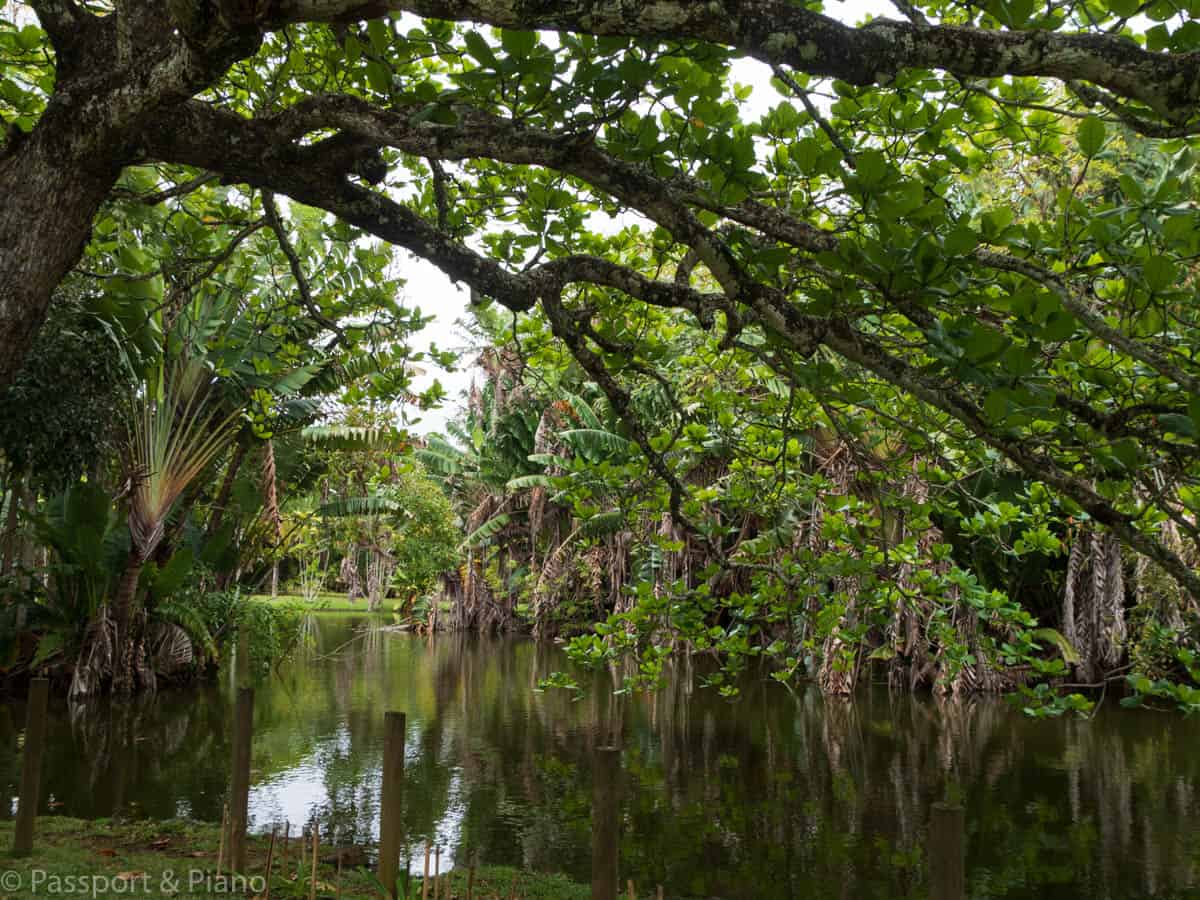
The French governor of Mauritius originally owned the private gardens which began as a vegetable plot for his Mon Plaisir château in 1735. Much of today’s magnificent species are the result of the French botanist Pierre Poivre.
He collected seeds from around the world and planted them in the garden from 1768. His mission was to eliminate the need for France to import spices from Asia and in the medicinal garden, you can see the fruits of his labour.
Nicolas Céré took over from Poivre in 1775 and added his stamp on the site with ponds and pathways.
Giant Lilly Pond
The most significant being the giant water Lilly pond which the magnificent Victoria amazonica (giant Lily) now thrives in. The giant water lilies can reach 3 meters in diameter and produces stunning flowers. The flowers last only for three days.
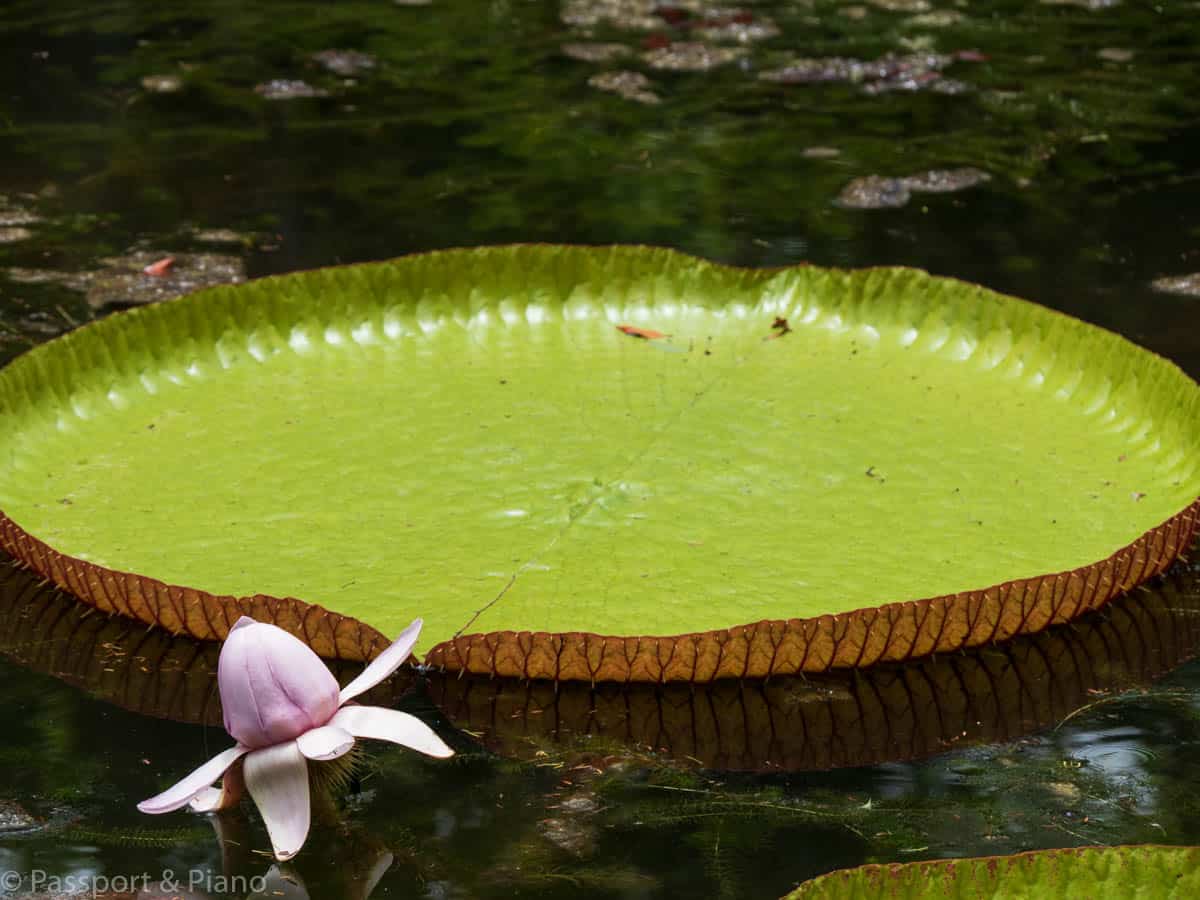
On the first day, they are white, on the second they turn a beautiful shade of pink and on the third day they sink to turn into a seed capsule.
In 1810 the botanical garden was sadly neglected as the British took over rule of the island. However, James Duncan began its rival in 1849, and the royal palms are one of his stunning contributions.
In 1988 the Royal botanical gardens were renamed the Sir Seewoosagur Ramgoolam botanic garden. He was the first Prime Minister of Mauritius, and there is a monument in his honour near the château with a lotus flower on the top.
Memorial Garden
For Hindus, the lotus flower symbolises beauty and eternity, and it is representative of someone who spiritual and wise. In the surrounding gardens around the monument, you’ll see plaque signs with various dignitaries and royal family members. All of which have planted trees in recent decades.
You can find the names of other people who have contributed plants and trees to the garden on the Colonne Lienard monument. The white marble monument is near the main entrance, which has beautiful wrought iron gates.
Close to the gates are some spectacular Baobab trees, and if you look up as you wander around this section, you will probably see the fruit bats hanging in the branches.
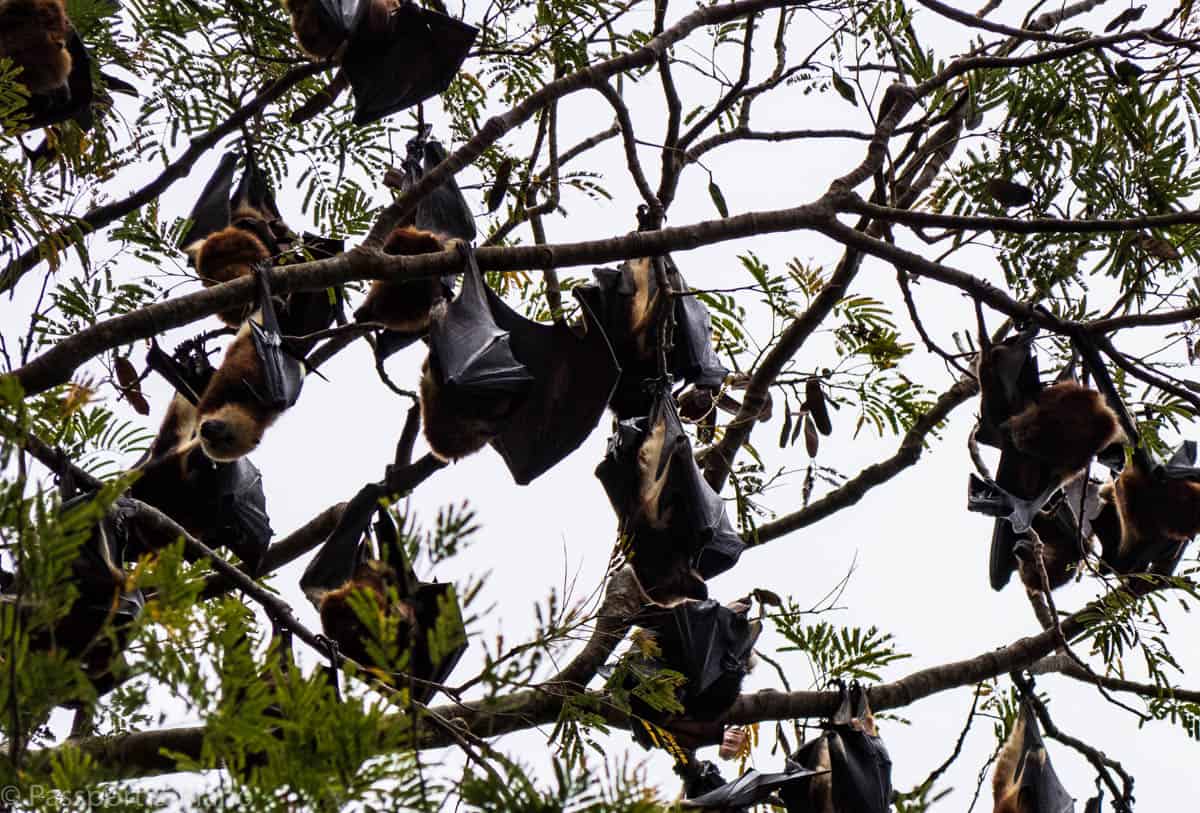
Most people enter through the car park, which is not near the main gates hence unless you take a guided tour it’s easy to miss this section of the garden.
Wildlife – Giant Tortoise and Deer
As well as plants the botanical gardens are one of the Mauritius tourist places that keep giant tortoises. There’s a large pen next to the deer enclosure, and the size of some of them is incredible.
The tortoises are from Seychelles and were reintroduced to the island when the Mauritian species became extinct. After the Galapagos tortoise, the Aldabra is the second largest in the world.
The botanical gardens are an excellent place in Mauritius to spot birds. By the water, you can see kingfishers, and there’s plenty of bright orange Madgascan Foddies to spot in the trees.
Opening Times
The gardens are open daily between 8.30 am and 5 pm. Entrance is 200 rupees, and there’s plenty of space on the car park. Pamplemousse is to the north of Port Louis, and there are signposts from both directions.
If you are unable to walk around the gardens, there are golf buggies which you can hire. Guides give regular tours for a small fee, but the map that you receive with your entrance ticket is adequate.
Whatever the time of year the mosquitoes in Mauritius love this green oasis on the island so don’t forget to cover yourself with insect repellent if you are prone to be bitten.
Boat trip to Îlot Gabriel – north island Mauritius
A north island tour Mauritius is a great way to spend a day. The turquoise blue water and gorgeous sandy beaches make this area one of the most beautiful places in Mauritius.
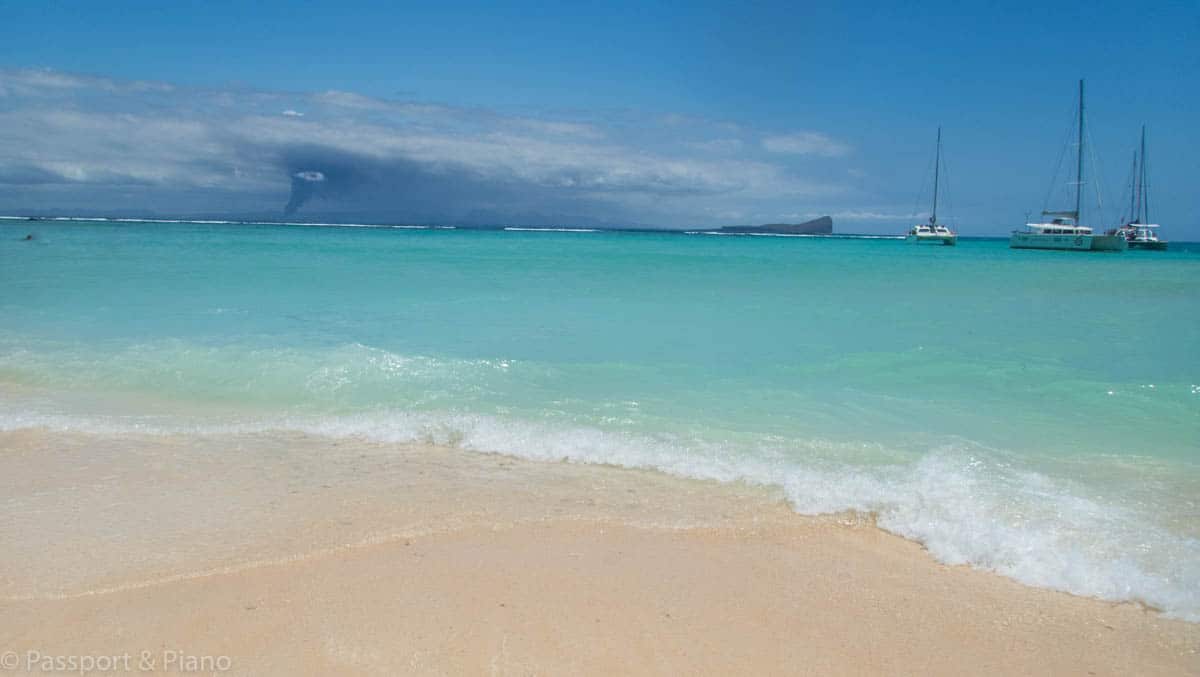
Boat trips depart from Grand Baie (Bay) daily at 9 am, and most include a BBQ by the island. The catamarans used are spacious, and there’s plenty of seating space available either in the sun or shade.
They cruise at a slow speed, and there’s plenty of views to admire both of the north coasts of Isla Mauritius and the islands that you pass along the way. Look out for the colony of long-tail tropic birds that circle Coin de Mire Island on the route.
If you’re lucky, you may also pass dolphins and whales in the open sea. The journey from Grand Bay takes approximately one and a half hours.
Snorkeling on Gabriel Island
When you reach Gabriel Island, the catamarans have to drop anchor out to sea, so transfer to the beautiful beach is by dingy.
The water around the island is crystal clear, and there’s some excellent snorkelling just off the beach.
The best of the coral reef is at the end of the beach opposite where the catamarans are. Most people don’t swim at this end as the current is stronger. However, if you are an able swimmer walk to the end of the beach and swim out to the right approximately 400 meters and you’ll find the coral reef.
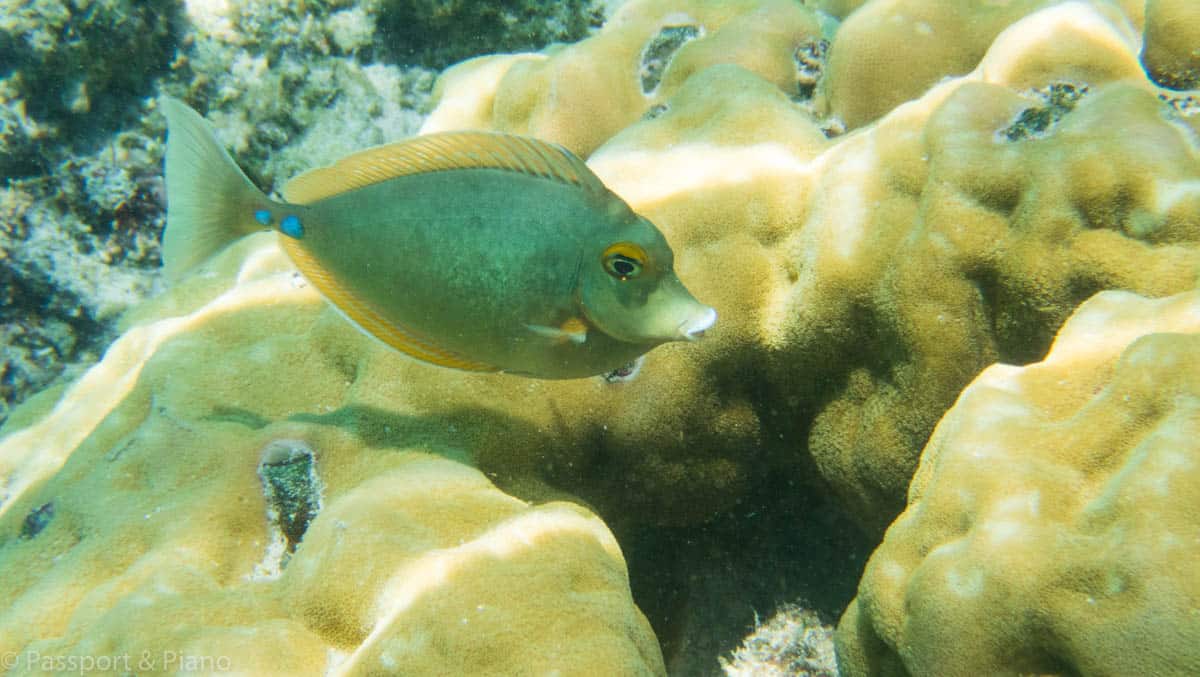
There’s plenty of fish to see, including plenty of Trigger and Angelfish. The clarity of the water is excellent, and even if you only snorkel in the Bay with the majority of day-trippers, you’ll see some beautiful fish.
You get to spend a couple of hours on this stunning Mauritius island before heading back to the catamaran for a BBQ lunch. Most tours can cater for vegetarians if you request in advance and options usually include grilled meats, fish and a variety of salads.
The food is delicious, and vegetarians generally get a tasty curry to enjoy. On the way back to Grand Bay the boats usually stop at another spot for some snorkelling around one of the other islands.
The sea is often much deeper, but the clarity of the water is so excellent you can easily see to a depth of 5 or 6 meters.
The trip around the islands is one of the most popular things to do in Grand Baie, so make sure you reserve your place ahead online so that you don’t miss out.
Casela World of Adventures
If you’re looking for other things to do in Mauritius with kids other than visiting the beach a trip to Casela World of Adventures should be top of your list.
It’s a nature park that’s home to many African animals, and there’s plenty of fun things to do in Mauritius here. Activities include ziplining, quad biking and Segway adventures.
You can interact with lions and cheetahs or take a camel ride. There’s also tortoise feeding and a petting area for younger kids. You can try your hand in a round of mini-golf or enjoy a walk around the splendid surroundings.
Even if you do not wish to do any of the activities, it’s worth visiting to see the tortoises, the large aviary of exotic birds and enjoy a meal at the mirador restaurant.
Included in the entry ticket is a safari drive on which you’ll pass Zebras, lions, hyenas and cheetahs to name but a few.
Île Aux Aigrettes
For me, this is one of the activities in Mauritius not to miss. It was one of the highlights of my trip as the conservation work here is incredible.
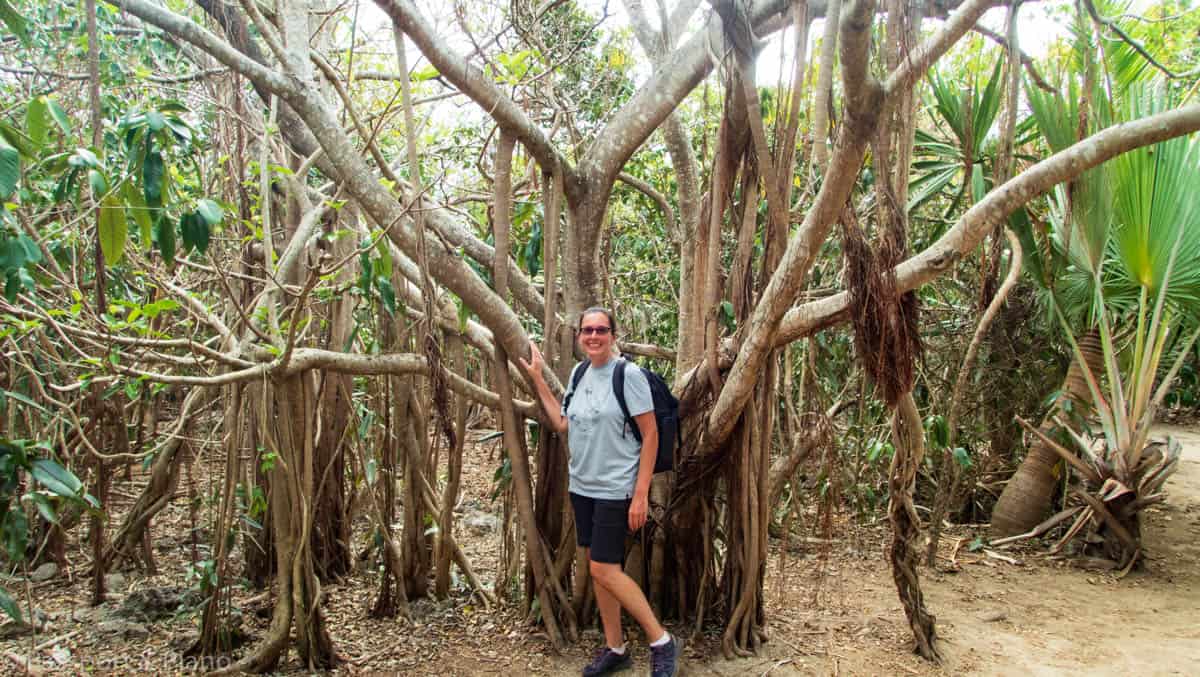
The small island is now a nature reserve. It represents what Mauritius used to look like before sugar cane farming, and the tourist industry stripped the islands of its original flora and fauna.
The Mauritius wildlife foundation began a massive planting program in 1985. First, they had to remove all the species that were not indigenous to Mauritius, which took over a decade.
The only magnificent trees that were endemic to the island were those in the ebony forest. Still, today the foundation has restored the balance.
The tour takes you through the woods, and some of the trees here are over 400 years old. Since the project began, they have reintroduced some of the most endangered species and been able to reproduce plants and trees to replant in other parts of Mauritius.
Endangered Species
The MWF has also done an incredible job at protecting some of the islands most critically endangered birds.
The pink pigeon is one of the worlds most successful conservation efforts, most of which took part here on Île Aux Aigrettes. In 1990 there were only ten birds left in the species, but the safe environment of the island has led to promising numbers of pink pigeons. The researches have now been able to release many of these back on the main island.
Fifty pink pigeons are now at home on Île Aux Aigrettes which is 10 % of the wild population. Hence, its one of the best places to visit in Mauritius if you want to catch sight of them.
The island is also home to 25 olive, white eye pairs. There are only between 100-150 pairs of these birds left in the world, so they are in critical danger. The tiny birds have a beautiful circle around the eye, but they are rather shy and incredibly challenging to spot.
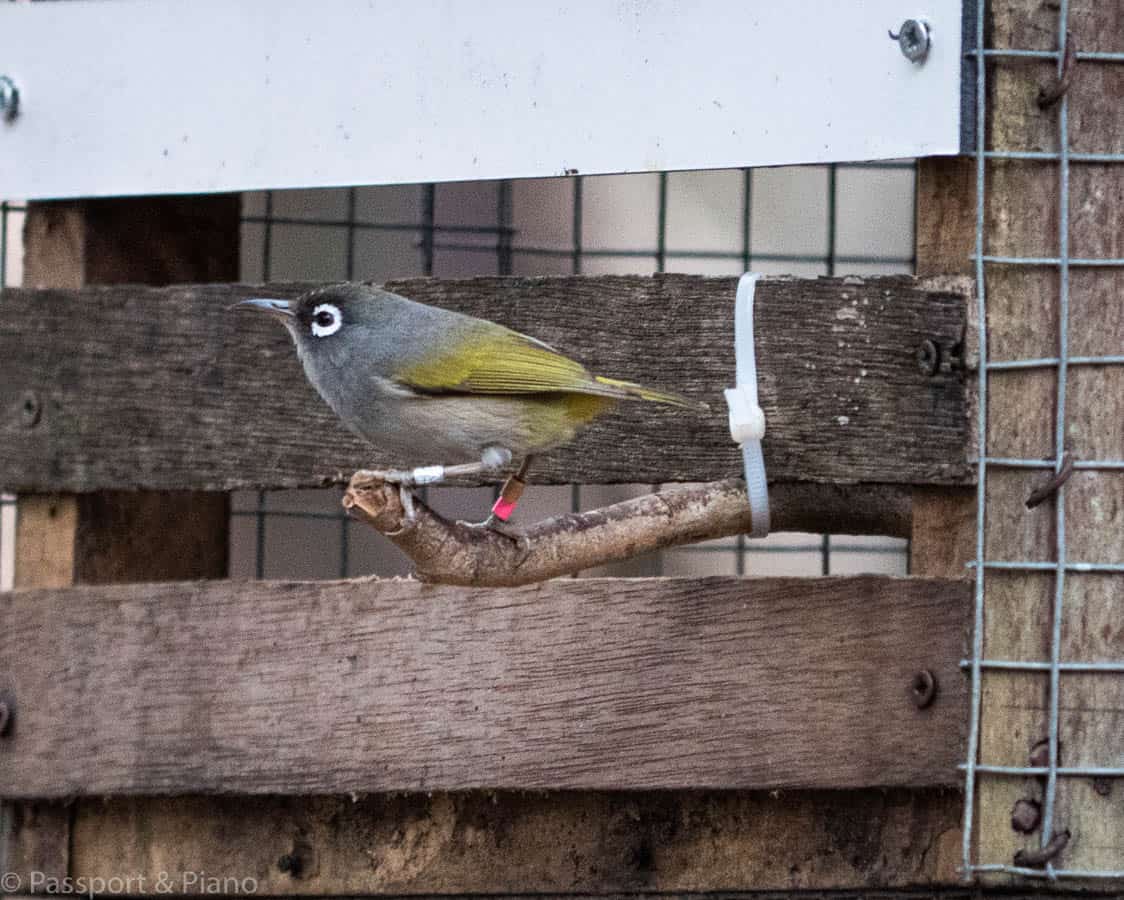
If you visit the island lookout around the bird feeders and you may get lucky like I did and catch sight of one.
Preservation and Research
The project has also had success at breeding Mauritian Foddies and about 25% of the world’s population, which is only 400 live on the island. The conservation work here is remarkable, and the efforts are ongoing.
The inspiration that you’ll take away from this island trip is phenomenal, and the conservation efforts give hope for many other endangered species.
The guided tour is both exciting and informative. Along the way, you’re likely to encounter the only wild Aldabra tortoises in Mauritius. There’s a good chance you’ll see the stinks. The foundation hopes that the stinks will eventually eradicate the Indian shrews which are not endemic to the island.
There’s also the opportunity to see the large Mauritian flying fox (giant fruit bats) up close. The island has several which were orphaned and no longer able to survive in the wild. The foundation keep them in a enclosure as they cannot fend for themselves. Hence, it’s an excellent opportunity to see them in close quarters.
To get to the island boats depart from Pointe Jerome which is a couple of kilometres from blue Bay. The ticket office is opposite the embarkation point just 250 metres southeast of the Le Preskîl Hotel.
The tour is an outstanding value for money, and this is one of only a handful of Mauritius excursions that allows you to contribute to the islands incredibly successful conservation efforts.
Hiking Le Morne
Snorkelling and diving are the focus of many activities to do in Mauritius. Still, the island also offers fantastic hiking opportunities. One of the best is the trail up Le Morne Brabant, which offers spectacular views of the Indian Ocean and its coral reefs.
The basaltic mountain sits right at the South West tip of the island and is a Unesco World Heritage site. The summit sits 556 metres above sea level. It is of considerable significance to the Mauritian people as it represents freedom from slavery.
Mauritius was an essential stop on the slave route, and many Africans, Indians and Madagascans escaped to take refuge on the mountain. They were known as the Maroon slaves, and their life of freedom on the Le Mourne was one of hardship and fear.
If the authorities caught them, punishments would include torture and possibly death. Sadly when the British abolished slavery in 1834, many of the maroon slaves climbed to the top of the mountain and committed suicide by jumping. They were so scared of the authorities that they never got to hear the news that they were free.
You can take a guided hike to the top of the mountain and experience the magnificent view along the way. For nature lovers and hiking enthusiasts, this is one of the best ways to experience Mauritius.
Along the Le Morne Brabant trail which takes between 3 to 4 hours to complete you’ll pass the caves which were the home of the slaves.
The final part of the climb is rather challenging and requires ropes and is only accessible with a tour guide. A large cross marks the highest point, and from here you get exquisite panoramic views of the island.
Port Louis Mauritius Attractions
For history lovers looking for what to do in Mauritius, a visit to Port Louis is a must. The island’s capital is home to another Unesco site, Aapravasi Ghat.
Between 1849 and 1923, half a million Indian labourers passed through these immigration buildings. The men were deployed by the British to work on the plantations.
When you visit the remains of these buildings, you get an insight into living conditions and the history of the country. For the Mauritian people, the site of particular interest as the vast majority are descendants of the workers who passed through Aapravasi Ghat.
A visit to the Blue Penny Museum should also be top of your things to do in Port Louis Mauritius list. The main attraction here is the one penny and two penny stamps.
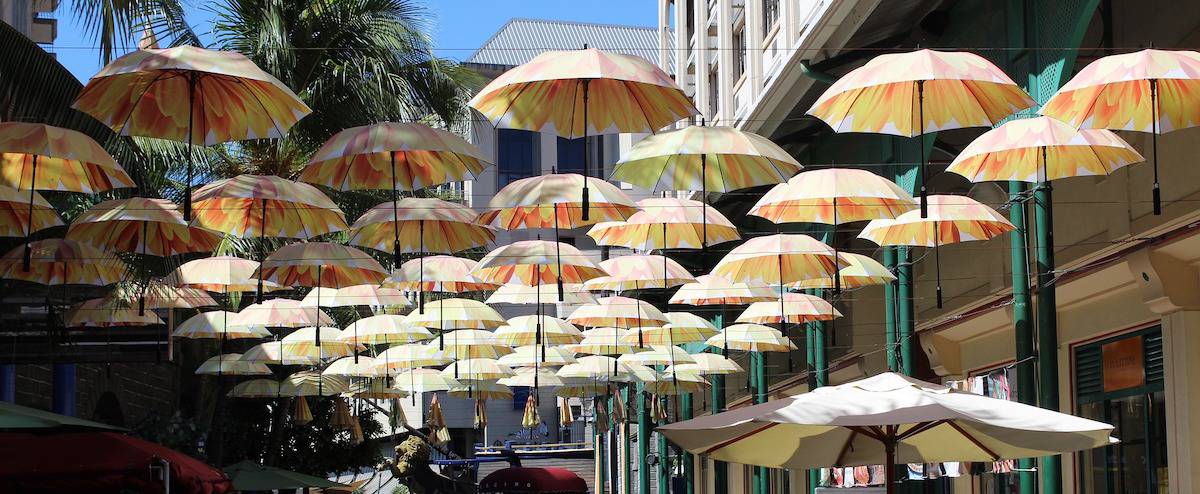
The museum is at the Caudan waterfront, and as well as being home to two of the most valuable stamps in the world, there’s an exciting collection of maps and paintings.
The museum is open between 10 am and 5 pm every day except Sunday and one hour guided tours are available on request. There’s also an excellent souvenir shop if you are looking to purchase some travel gifts to take home.
National History Museum
The beautiful mansion that houses the museum was owned by the Robillard family once owned. In the Battle of Vieux Grand Port, the building was a medical centre that treated the injuries of the French and English men. You can learn more about the battle on a visit here.
There are cannons on display along with other interesting artefacts. These include some fascinating coins from the St Géran ship which sank in 1744 off the northeast coast of the island.
The museum also has some bones from the extinct dodo which may be of interest to some. Entrance to the museum is free, and there’s parking within the grounds. The museum is in Mahebourg which is near Blue Bay.
île aux Cerfs
Île aux Cerfs is a picturesque island off the coast of Trou d’ Eau Douce in east Mauritius. Its renowned for its long sandy beaches are beautiful tropical lagoons.
You can snorkel off the beach, bathe in the sun or participate in the many things to do in île aux Cerfs. There are plenty of day trips from the island or its possible to stay one of the unique bubble lodges.
The island boasts an 18 hole golf course which is open daily from 7 am till 8 pm. Golf lessons are available, and the course has stunning views of the Indian Ocean from every hole.
There’s an adventure park where you can go zip lining and an abundance of watersports which include parasailing, speed boat rides, water skiing, wakeboarding and banana rides.
If you don’t fancy snorkelling, you can take a ride on one of the glass bottom boats. After viewing the spectacular underwater world treat yourself to a delicious meal in one of the beachside restaurants.
In peak season the island can get busy, but if you walk a kilometre or so down the beach, you’re likely to find a quiet spot.
On Saturday nights between October and March, the beach becomes a night club. The music kicks off around 11 pm, and you can party through the night until sunrise.
